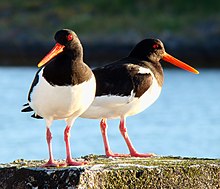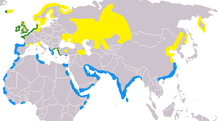Eurasian oystercatcher
| Eurasian oystercatcher | |
|---|---|

| |
| Scientific classification | |
| Domain: | Eukaryota |
| Kingdom: | Animalia |
| Phylum: | Chordata |
| Class: | Aves |
| Order: | Charadriiformes |
| Family: | Haematopodidae |
| Genus: | Haematopus |
| Species: | H. ostralegus
|
| Binomial name | |
| Haematopus ostralegus | |

| |
| Range of H. ostralegus Breeding range Year-round range Wintering range
| |
The Eurasian oystercatcher (Haematopus ostralegus) also known as the common pied oystercatcher, or (in Europe) just oystercatcher, is a wader in the oystercatcher bird family Haematopodidae. It has striking black and white plumage, a long straight orange-red bill, red eyes and relatively short dull pink legs. The sexes are similar in appearance but the bill of the female is longer than that of the male.
It is the most widespread of the oystercatchers, with three races breeding in western Europe, central Eurosiberia, Kamchatka, China, and the western coast of Korea. No other oystercatcher occurs within this area.
Taxonomy
[edit]The Eurasian oystercatcher was listed by Swedish naturalist Carl Linnaeus in 1758 in the 10th edition of his Systema Naturae under the binomial name Haemotopus ostralegus.[2] The genus name Haematopus combines the Ancient Greek haima αἳμα meaning "blood" and pous πούς meaning "foot". The specific epithet ostralegus combines the Latin ostrea meaning "oyster" and legere meaning "to gather".[3]
The name "oyster catcher" was coined by Mark Catesby in 1731 as a common name for the North American species H. palliatus, described as eating oysters.[4][5] William Yarrell in 1843 established this as the preferred term, replacing the older name sea pie.[6][5]
Four subspecies are recognised:[7]
- H. o. ostralegus Linnaeus, 1758 – breeds Iceland to Scandinavia and south Europe, winters in west Africa
- H. o. longipes Buturlin, 1910 – breeds Ukraine and Turkey to central Russia and west Siberia, winters in east Africa
- H. o. buturlini Dementiev, 1941 – breeds west Kazakhstan to northwest China, winters in southwest Asia and India
- H. o. osculans Swinhoe, 1871 – breeds Kamchatka Peninsula, Korean Peninsula, and northeast China, winters in east China
The extinct Canary Islands oystercatcher (Haematopus meadewaldoi), usually considered as distinct species, may have actually been an isolated subspecies or distinct population of the Eurasian oystercatcher.[8][9]
Description
[edit]
The oystercatcher is one of the largest waders in the region. It is 40–45 cm (16–18 in) long, the bill accounting for 8–9 cm (3–3+1⁄2 in), and has a wingspan of 80–85 cm (31–33 in).[10] It is an obvious and noisy plover-like bird, with black and white plumage, pink legs and a strong broad red bill used for smashing or prising open molluscs such as mussels or for finding earthworms.[10] The sexes are similar in plumage but the female has a longer bill than the male.[11] Despite its name, oysters do not form a large part of its diet. The bird still lives up to its name, as few if any other wading birds are capable of opening oysters.
This oystercatcher is unmistakable in flight, with white patches on the wings and tail, otherwise black upperparts, and white underparts. Young birds are more brown, have a white neck collar and a duller bill. The call is a distinctive loud piping.
The bill shape varies; oystercatchers with broad bill tips open molluscs by prising them apart or hammering through the shell, whereas pointed-bill birds dig up worms. Much of this is due to the wear resulting from feeding on the prey. Individual birds specialise in one technique or the other which they learn from their parents.[10] It shows clinal variation with an increase from west to east. The subspecies longipes has distinctly brownish upperparts and the nasal groove extends more than halfway along the bill. In the subspecies ostralegus the nasal groove stops short of the half-way mark. The osculans subspecies lacks white on the shafts of the outer 2–3 primaries and has no white on the outer webs of the outer five primaries.[12]
The American oystercatcher (Haematopus palliatus) differs from the Eurasian oystercatcher in having a yellow eye and blackish-brown rather than black dorsal plumage.[13]
Distribution and migration
[edit]The oystercatcher is a migratory species over most of its range. The European population breeds mainly in northern Europe, but in winter the birds can be found in north Africa and southern parts of Europe. Although the species is present all year in Ireland, Great Britain and the adjacent European coasts, there is still migratory movement: the large flocks that are found in the estuaries of south-west England in winter mainly breed in northern England or Scotland. Similar movements are shown by the Asian populations. The birds are highly gregarious outside the breeding season.
Breeding
[edit]
The mating system is monogamous and the pair-bond usually lasts for the many years. They first breed when they are between three and five years of age.[14] The nest is a bare scrape on pebbles, on the coast or on inland gravelly islands. Two to four eggs are laid. On average the eggs are 57 mm × 40 mm (2.2 in × 1.6 in) in size and weigh 47 g (1.7 oz). They are buffish-yellow in colour with black-brown blotches and streaks. Beginning after the last egg is laid, they are incubated by both parents and hatch synchronously after 24–27 days. The young are precocial and nidifugous.[15] They are brooded by both parents and leave the nest after one or two days.[16] They are fed by both parents. Only one brood is raised in a season.[15] Both eggs and chicks are highly cryptic.
Status
[edit]Because of its large numbers and readily identified behaviour, the oystercatcher is an important indicator species for the health of the ecosystems where it congregates. Extensive long-term studies have been carried out on its foraging behaviour in northern Germany, the Netherlands, and particularly on the River Exe estuary in south-west England.[17] These studies form an important part of the foundation for the modern discipline of behavioural ecology.
Gallery
[edit]-
parent with chick, Skomer Island
-
Four adults in flight (Hamburger Hallig, North Frisia)
-
Heligoland
-
Only three weeks old and fully ready to fly.
References
[edit]- ^ BirdLife International (2019). "Haematopus ostralegus". IUCN Red List of Threatened Species. 2019: e.T22693613A154998347. doi:10.2305/IUCN.UK.2019-3.RLTS.T22693613A154998347.en. Retrieved 11 November 2021.
- ^ Linnaeus, Carl (1758). Systema Naturae per regna tria naturae, secundum classes, ordines, genera, species, cum characteribus, differentiis, synonymis, locis (in Latin). Vol. 1 (10th ed.). Holmiae (Stockholm): Laurentii Salvii. p. 152.
- ^ Jobling, James A (2010). The Helm Dictionary of Scientific Bird Names. London: Christopher Helm. pp. 184, 286. ISBN 978-1-4081-2501-4.
- ^ Catesby, Mark (1729–1732). The Natural History of Carolina, Florida and the Bahama Islands (in English and French). Vol. 1. London: W. Innys and R. Manby. p. 85, Plate 85.
- ^ a b Lockwood, W. B. (1993). The Oxford Dictionary of British Bird Names. Oxford University Press. p. 113. ISBN 978-0-19-866196-2.
- ^ Yarrell, William (1843). A History of British Birds. Vol. 2. London: J. Van Voorst. p. 432.
- ^ Gill, Frank; Donsker, David; Rasmussen, Pamela, eds. (July 2021). "Buttonquail, thick-knees, sheathbills, plovers, oystercatchers, stilts, painted-snipes, jacanas, Plains-wanderer, seedsnipes". IOC World Bird List Version 11.2. International Ornithologists' Union. Retrieved 21 November 2021.
- ^ Senfeld, T.; Shannon, T.J.; van Grouw, H.; Paijmans, D.M.; Tavares, E.S.; Baker, A.J.; Lees, A.C.; Collinson, J.M. (2019). "Taxonomic status of the extinct Canary Islands Oystercatcher Haematopus meadewaldoi". Ibis. 162 (3): 1068–1074. doi:10.1111/ibi.12778. hdl:2164/15137.
- ^ Collar, N.J.; Donald, P.F.; Kirwan, G.M. (2021). "Species, subspecies or morph—what was the Canary Islands Oystercatcher?". Ibis. 163 (4): 1500–1505. doi:10.1111/ibi.12980.
- ^ a b c Snow, D.W.; Perrins, C.M., eds. (1997). The Birds of the Western Palearctic. Vol. 1 (Abridged ed.). Oxford University Press. pp. 535–538. ISBN 0-19-854099-X.
- ^ Cramp 1983, p. 17.
- ^ Hayman, Peter; Marchant, John; Prater, Tony (1986). Shorebirds: An Identification Guide to the Waders of the World. London: Croom Helm. ISBN 978-0395602379.
- ^ Hockey, P.A.R. (1996). "Family Haematopodidae (Oystercatchers)". In del Hoyo, J.; Elliott, A.; Sargatal, J. (eds.). Handbook of the Birds of the World. Vol. 3: Hoatzin to Auks. Barcelona, Spain: Lynx Edicions. pp. 308-325 [323]. ISBN 978-84-87334-20-7.
- ^ Cramp 1983, p. 23.
- ^ a b Cramp 1983, pp. 32–33.
- ^ Cramp 1983, p. 28.
- ^ Goss-Custard, J. D. (Ed.) (1996). The Oystercatcher: From Individuals to Populations. Oxford: Oxford University Press. ISBN 9780198546474
- ^ Yves Le Marquand (19 August 2019). "Lihou can fly own flag". Guernsey Press. Retrieved 31 August 2024.
Sources
[edit]- Cramp, Stanley, ed. (1983). "Haematopus ostralegus Oystercatcher". Handbook of the Birds of Europe the Middle East and North Africa. The Birds of the Western Palearctic. Vol. 3: Waders to Gulls. Oxford: Oxford University Press. pp. 17–35. ISBN 978-0-19-857506-1.







![Flag of the island of Lihou, featuring a Eurasian oystercatcher.[18]](http://upload.wikimedia.org/wikipedia/commons/thumb/9/9a/Flag_of_Lihou.svg/120px-Flag_of_Lihou.svg.png)